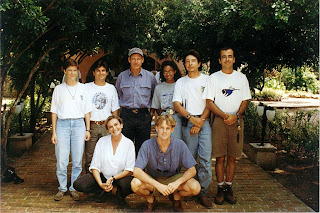.
..
SEE PART 1 OF THIS STORY ..
.
 Another mission accomplished:
Another mission accomplished:
please welcome the freshwater stingray!Photo: © Daniel De Granville, 2010Ten days and
57 meters of anaconda later, already with the feeling of "mission accomplished", it was time to leave Bonito in search of our trip’s second objective: the freshwater stingrays. After my pre-production research, the region of Nobres – in the Savannas of Mato Grosso – was chosen as the ideal spot. Even though we had found some rays in Bonito, the visibility conditions in this new region were more promising, since – according to what we had heard – they occurred in areas closer to the river springs, where the water tends to carry less sediments, which is good for photography.
Upon arrival in Cuiabá, our local support team – Hélio and Jadilson – were already waiting. We followed on to the region of Bom Jardim, a district of Nobres, where we were supposed to stay for the next four days, before heading on to the Amazon to search for Pink River Dolphins. After settling down in our lodge we met for the traditional logistics discussion and, for the following day, decided to explore a river where the chances of finding stingrays were good.
 Our well equipped Shaowen, before the first
Our well equipped Shaowen, before the first
encounter with a ray, tries to overcome a fallen tree,
while little fish seem amused by the view.Photo: © Daniel De Granville, 2010
Next morning. After the detailed preparation of all necessary gear – masks, regulators, fins, tanks, weight belts, neoprene wetsuits, snacks, sandwiches, drinks, cameras, lenses, batteries, vehicle, etc, etc, etc – we left on our new adventure. The first hour, at least for me, was rather tense, since we did not see a single stingray in the river and I could catch a certain glimpse of frustration coming from the rest of our team – specially after such as blast with anacondas. That’s when our guide Jadilson suggested:
“Let’s continue downstream through the part that tourists don’t go, because stingrays are shy and may be concentrated elsewhere. But it will not be an easy drift, since there are fallen branches and trees both above and below water”. Said and done: it was really a more complicated way down the river, with all the gear getting tangled on the vegetation, but our reward came soon: at the first 100 meters of this new way, stingrays started showing up. And after the first one came another, and another, and another, until we totalized eight freshwater stingrays of various sizes to appease our photographers.
 Jiří photographing one of the eight stingrays
Jiří photographing one of the eight stingrays
that we met on the same stretch of the river.Photo: © Daniel De Granville, 2010The sudden success was so surprising that, after the first day was gone, the team considered that they had photographed stingrays in every possible way. So, a change of plans became a possibility. They asked for my suggestion and I – eternally in love with the Pantanal – recommended a two-day “pantaneira” expedition. Even though there was nothing underwater to be photographed there, they surprisingly agreed... The story goes on in the next post!
 A pause on the dives to watch the flight of the macaws before saying goodbye to Nobres.Photo: © Daniel De Granville, 2010
A pause on the dives to watch the flight of the macaws before saying goodbye to Nobres.Photo: © Daniel De Granville, 2010.
.
.



















































